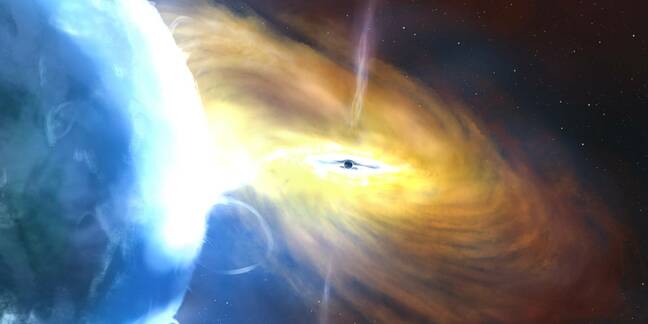Astronomers say they've seen the largest explosion yet – and we just had to talk to them
The culprit: A supermassive black hole, a billion times more massive than the Sun, feeding on a giant gas cloud
Astronomers have observed the largest explosion yet in space that we're aware of, a years-long event involving a supermassive black hole estimated to be one billion times more massive than the Sun that continues to rage.
The eruption, codenamed AT2021lwx, was first recorded by ground-based telescopes – the Zwicky Transient Facility in California, and the Asteroid Terrestrial-impact Last Alert System in Hawaii – in 2020. A team analyzing data from those instruments later realized what had been captured was extraordinarily bright, and fit the profile of a supermassive black hole gobbling up matter.
"We came upon this by chance, as it was flagged by our search algorithm when we were searching for a type of supernova," Philip Wiseman, a research fellow at the University of Southampton in England, who led the research published in the Monthly Notices of the Royal Astronomical Society, said on Friday.
"Most supernovae and tidal disruption events only last for a couple of months before fading away. For something to be bright for two plus years was immediately very unusual."
The brightest explosion ever detected from Earth so far is the gamma ray burst GRB 221009A, and that lasted only about ten hours. Although AT2021lwx is less bright, the energy ejected over time is greater since the explosion has blazed on for years and continues to do so.
- Ten-day optical burst shows star eating giant planet, scientists say
- I've seen things you wouldn't believe, like an atom about to photosynthesize
- Hubble spots stellar midwife unit pumping out baby planets
- Space: The final frontier, or the next venture capital gold rush
The astronomer team believes this rare event has lasted so long because the supermassive black hole at the heart of it has been feeding on matter from a gigantic gas cloud, possibly thousands of times more massive than the Sun. As material is pulled and swallowed by the void, it is compressed into a disk-shape. Frictional forces heat up the accretion disk, and eject beams of electromagnetic energy.
We just have to keep watching to find out
"Usually a supernova, or a sun-like star falling into a black hole, lasts a few months because there just isn't enough material to power them for any longer before they fade away," Wiseman told The Register.
"This one must last so much longer because it has so much material to feed the black hole. It is still going, we can still see it with our telescopes and should be able to for at least a few more years. However, these things are unpredictable so there's a chance it suddenly fades away or even that it starts getting brighter again, we just have to keep watching to find out."
The supermassive black hole is located eight billion light years away, and is believed to have formed when the universe was around six billion years old - less than half of its current age.
"With a quasar, we see the brightness flickering up and down over time. But looking back over a decade there was no detection of AT2021lwx, then suddenly it appears with the brightness of the brightest things in the universe, which is unprecedented," Wiseman said.
The team will continue to study the explosion, and is planning to observe it with spacecraft such as NASA's Hubble Space Telescope or the James Webb Space Telescope to try and hunt for the galaxy housing the supermassive black hole.
"It's important because everything we are made of has been processed through stars and ejected across space by supernovae. Black holes and exploding stars are what sculpt galaxies, and tell us how the Universe and ultimately the solar system and Earth came to look how they do today," Wiseman told us. ®

